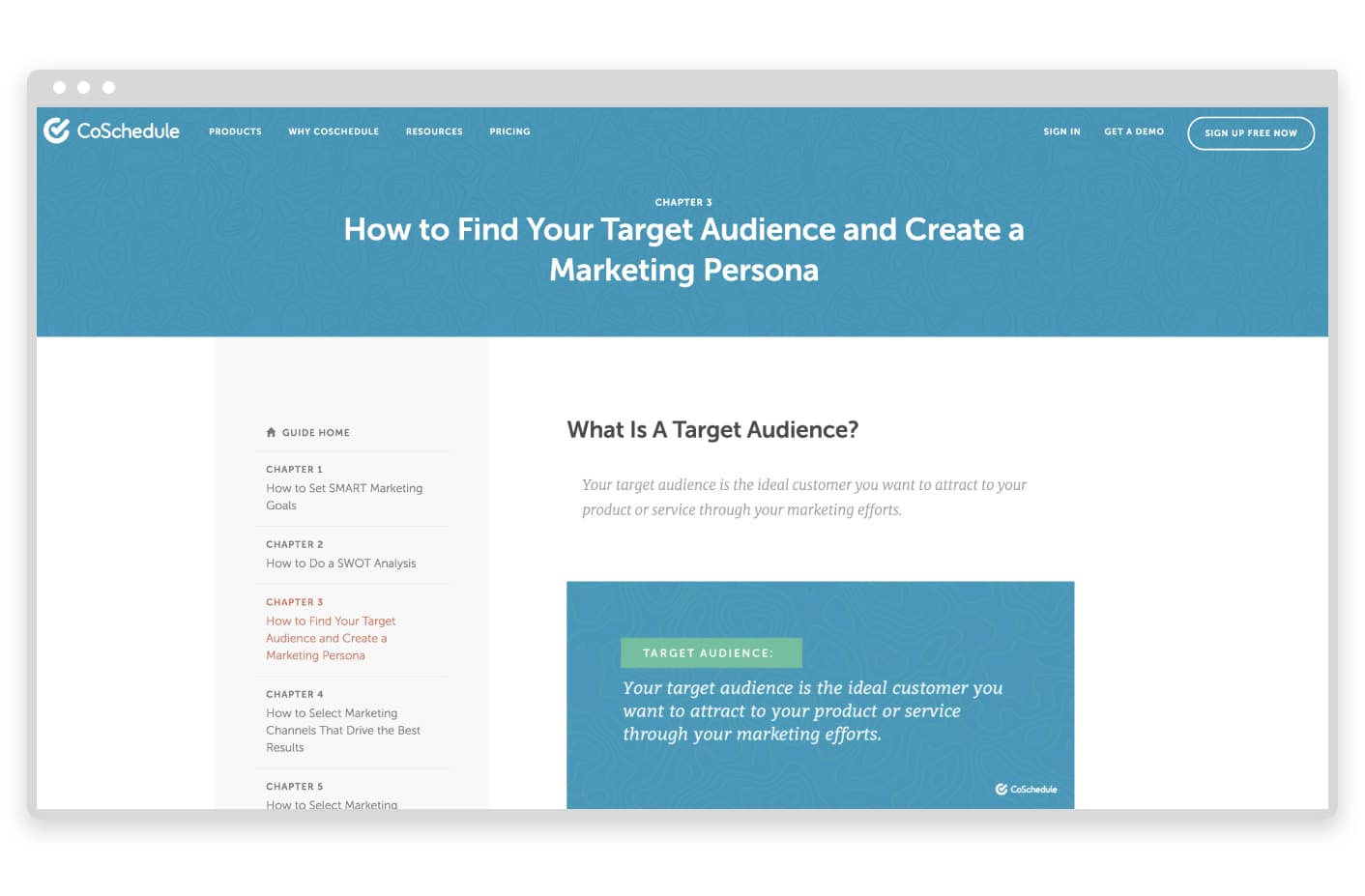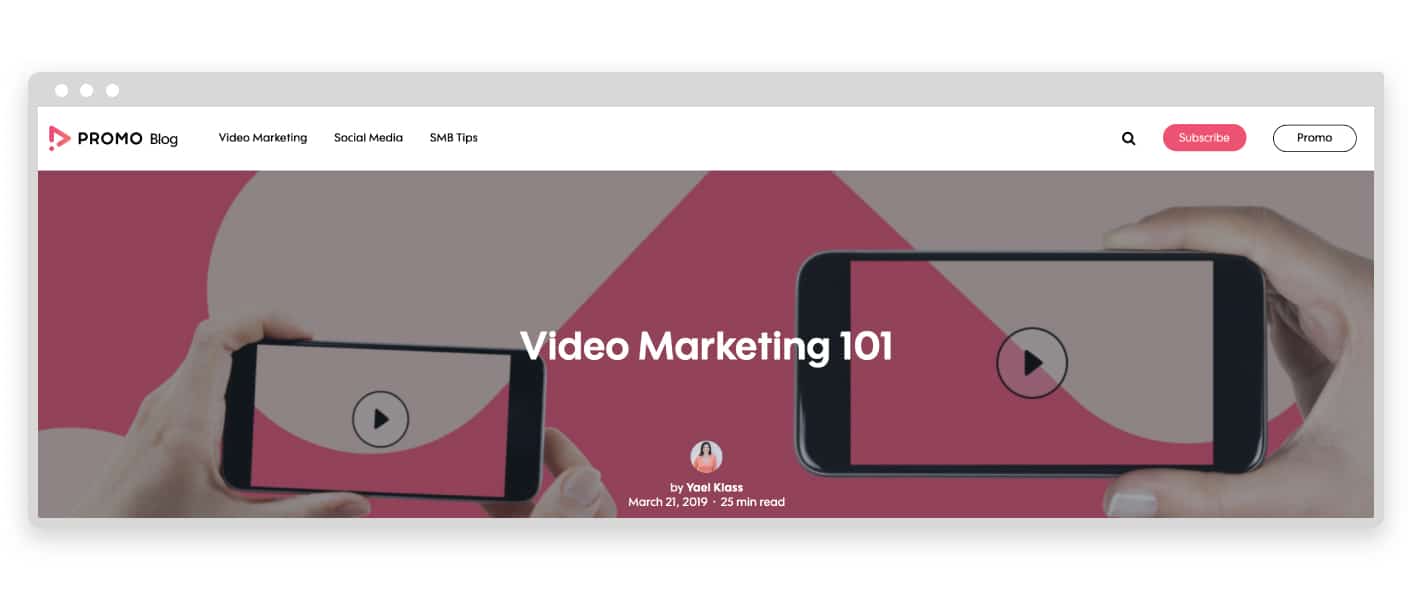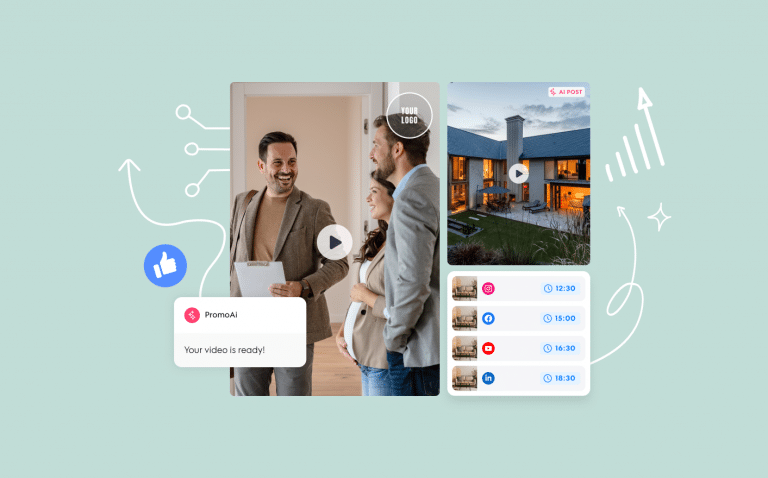How to Make a Brand Video
Unlike Arya of Winterfell, your company only has one face–and it’s crucial to your success. That face is called your brand.
Your brand is how customers, competitors, and suppliers perceive you in the marketplace. Are you a hip and trendy business or a conservative, trustworthy business? Effective branding is a crucial part of any marketing strategy.
In a digitally powered world, the face of your business is made up of multiple components. For instance, if you’re a brick and mortar, you have not just your storefront to manage, but you have your website and an entire online presence to take care of too.
While relatively new for most businesses, one highly impactful–but underutilized–component is the branding video.
In case you haven’t heard, video marketing is taking over, and that goes for your branding as well. Branding is what makes your company stand out and allows your target audience to pick you out of the huge, competitive crowd, especially on social media.
Now that you know what’s at stake, it can seem pretty overwhelming, but not to worry, we are here to show how to make a brand video and walk you through every step of the way.
If you already have a plan, head on over to Promo.com and easily make your own branding video to show the world the face of your business.
What is a branded video?
This is an important question because there are so many videos types out there. It’s good to know what falls under this particular category and what makes a video especially effective at positioning your brand in the mind of the viewer. Yet, when you try to search for the answer online there’s much left to be desired.
The good news is that the answer to this question isn’t very complicated.
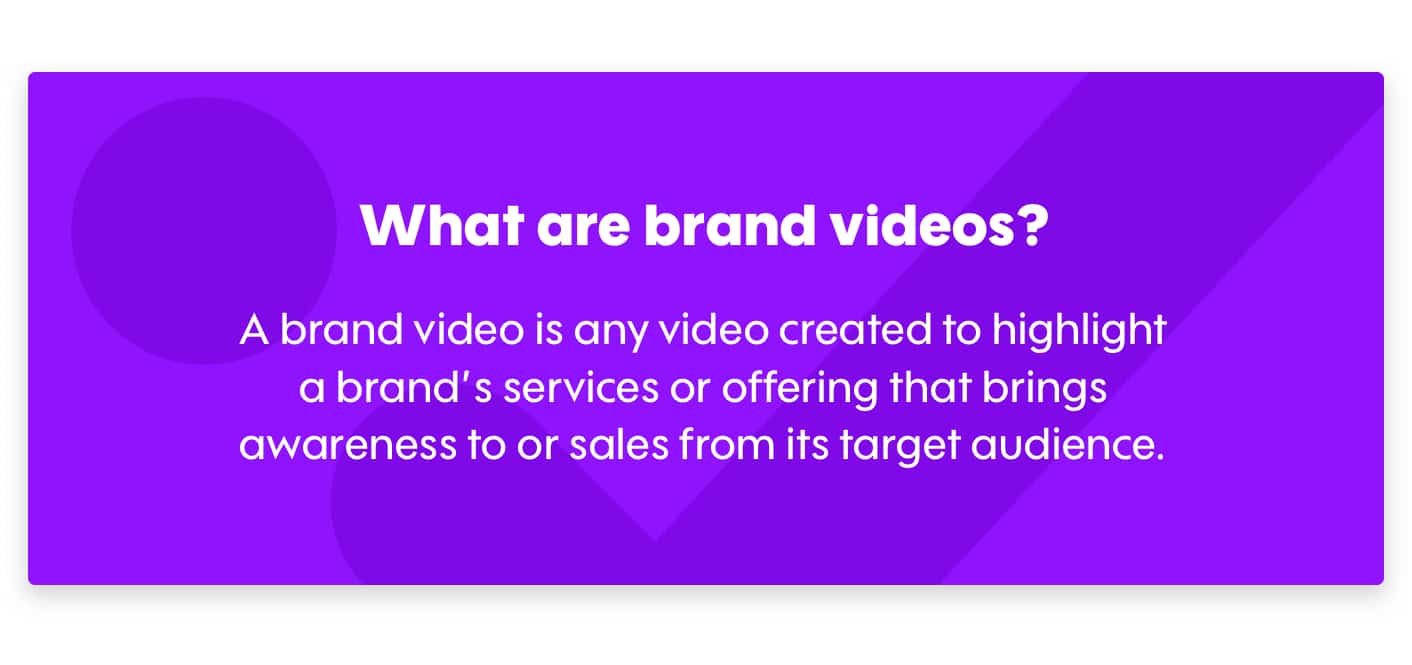
A brand video is any video that drives awareness and contributes to the perception of your business and its offerings.
Keep in mind that the key defining factor for a brand video is that it highlights, well, your brand. That means it doesn’t need to advertise a specific product or service outright. The goal here should be to establish your brand in the mind of the audience first and foremost.
What it is not is a poorly edited, low-quality video. Or at least it shouldn’t be. As a word of caution, 62% of consumers are more likely to have a negative perception of a brand that published a poor quality video. High-resolution videos that imbue emotion or tell a story is going to go a long way in the realm of branded video and quality matters to your viewers.
But sometimes, examples are worth more than words so let’s take a look at some good brand videos.
Inspiring brand videos examples
While there are a lot of mediocre and downright awful branding videos out there, if you dig around, you can actually find some exceptional and inspiring brand videos. Lucky for you, we did the dirty work.
Slack – Case study video
Take, for instance, this b2b case study video from Slack.
Even though it’s a case study, it’s light-hearted and funny while highlighting how Slack helped another business streamline some of their internal processes. (Also notice the HD quality. *sigh* we love it too.) For all of you B2Bs out there, this company brand video is a great one to take as your muse.
Hubspot – Explainer video
This explainer video (also called a brand overview video) is a branding video model that does a fantastic job of — as the name suggests — explaining what the company does.
LEGO – Origin story video
You can go a step further and do what LEGO did by creating a video showing the origin story of how they came to be the brand they are today.
Everyone loves a good origin story, and with more than 24 millions views, this video seems to resonate a lot with people. The style of this video is unique since it’s animated, but it goes to show that a good story is told in many different formats.
If you’d like even more examples of branded videos, Storyhunter has an inspirational list worth bookmarking.
What is branding?
Let’s take a quick step back and think about what the word branding actually means and how it can inform the process of creating an effective brand video.
Most people would think that a logo makes a brand. But the truth is there is much more to branding than creating a logo that fits your business name.
Now, here is where we’re going to drop a bit of a knowledge bomb on you.
Your logo, business name, color palette, and slogan, are not your brand; your customer’s perception of you is your brand.
The best way to understand this is by looking at your business is as if it is a person. It interacts with people on a day-to-day basis, it builds relationships, and it has its own personality and value.
All of your daily interactions, such as customer service, social media posts, content marketing, and especially the video content you put out there — is what leaves people with a lasting impression of your brand.
Your marketing efforts as a brand should all have the underlying goal of becoming more recognizable, a goal which you can measure by studying your analytics for branded searches.
That’s where branded video come in to play.
Branding video benefits: Why your brand needs videos
According to Inc.com, “46% of consumers said they have actually made a purchase after watching a branded video on social media, and nearly a third (32%) have considered doing so.” The study went on to say that, “79% of the participants agreed that online videos on social media are the easiest way to get to know a brand online.”
You can basically read that data like this:
Brand videos = revenue + brand awareness
In general, video marketing content is something that Google really loves. In fact, you’re 53x more likely to get on page one of Google if you have a video on your website.
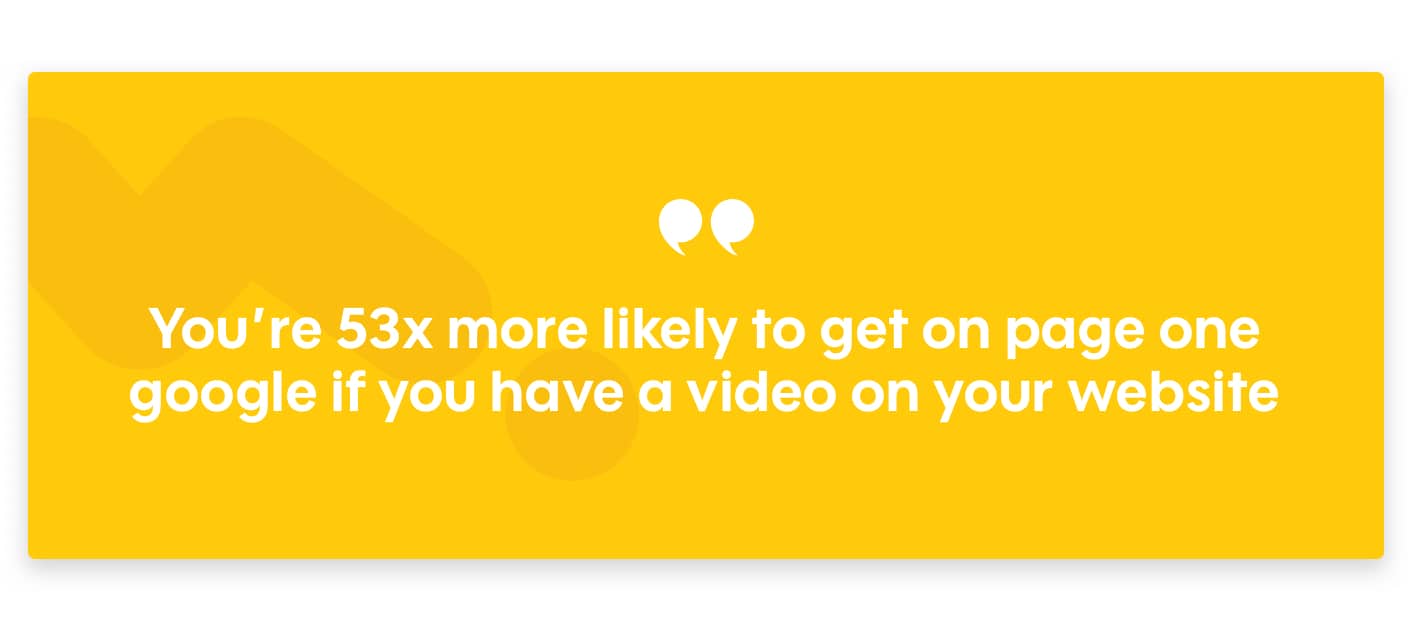
Studies have shown that adding a branded video to a landing page can increase conversions by 80%. Using branded videos as part of your branding efforts will definitely pay off, but knowing and doing are very different things.
And since this is likely new territory for you, we’re happy to lend a helping hand.
How do you brand yourself or establish a brand?
Before you start branding anything, you need to determine the type of brand you’re building because each one’s a little different.
There are three types of branding:
- Business branding. This is the type of branding you’ll encounter when dealing with most businesses today. You can think of Target, McDonald’s, Starbucks, Disneyland and so many more. As you think of each name listed, no doubt the colors, logos or mascots of each will pop into your head.
- Personal branding. You may not realize it, but everyone has a personal brand. Thanks to social media, we’re all building an online identity with every post, Story, and Tweet we share. But when you decide to wrangle your personal brand, the focus here is to, “differentiate yourself (the product) in the market so you can attain your objectives. If your objective is to become a well-known fitness trainer, then the type of stories and personality you bring to the table would be very different from someone whose objective is to become a well-known artist. Take, for instance, Muhammed Ali versus Adele. Both have a grounded personal brand, but they’re different in how they’ve approached building that public image.
- Professional branding (career branding). This is like Personal Branding 2.0 but it’s really not all that different from personal branding. The goal is still to differentiate yourself from others, but with the aim to grow your presence in a certain professional field and increase your value in the eyes of a potential employer. Great examples of this would be people like Guy Kawasaki or Sheryl Sandberg.
While different, all types of branding require these three preconditions:
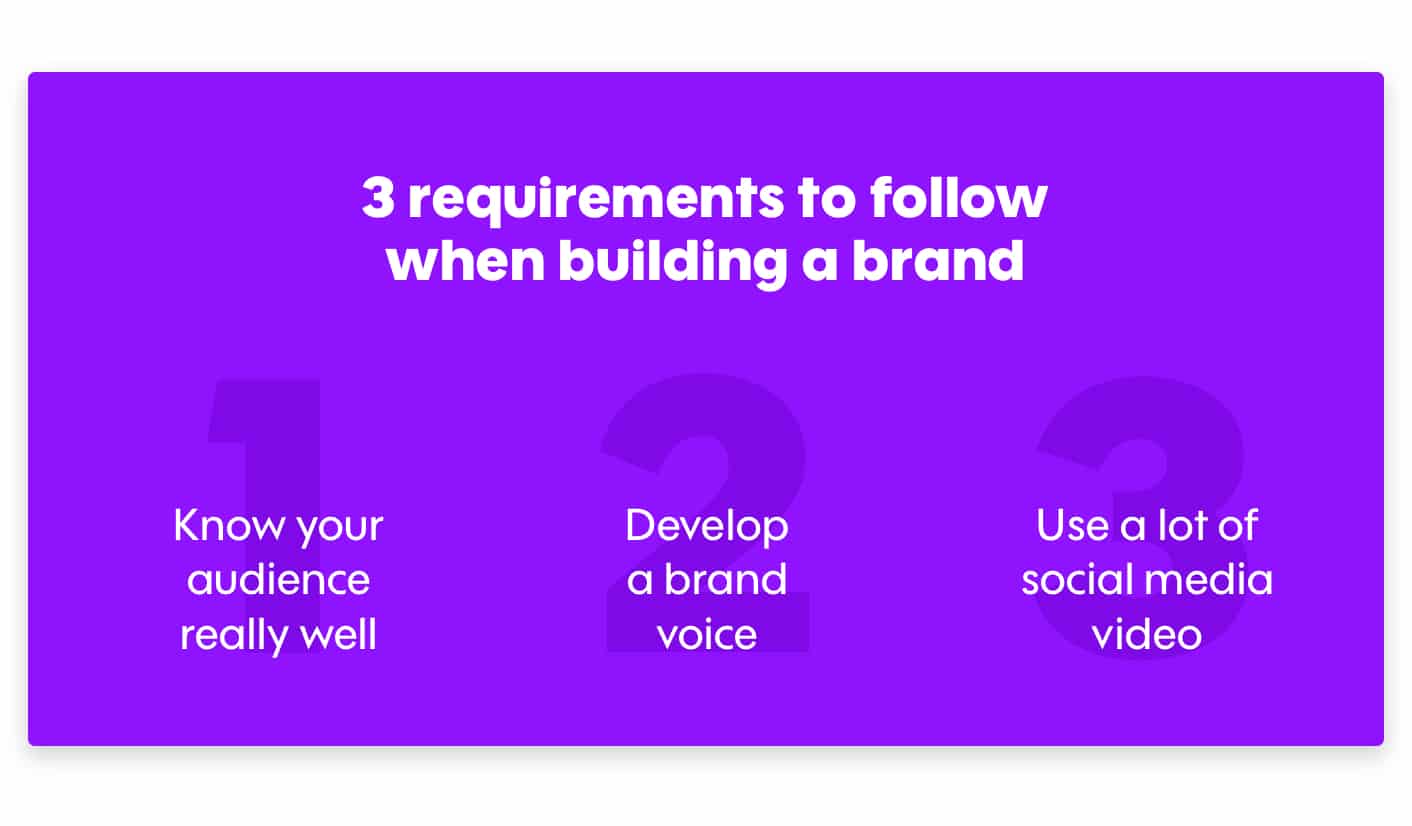
- Know your target audience. If you try to appeal to everyone, you’ll appeal to no one. When you know who you’re trying to attract, you know how to best frame your brand.
- Develop a unique but true-to-you brand voice. According to CoSchedule, a brand voice “refers to the personality and emotion infused into a company’s communication.” They also have a really great resource to help you establish your brand’s voice where many of the points work for personal branding too.
- Build a consistent social media presence that includes a lot of video content. When it comes to establishing any brand, having a consistent, cohesive social media presence is vital. And today, with the rise of video, using branded video content is pretty much the lifeblood of building a brand that stands the test of time.

The data says it all: “64% of consumers say that watching a marketing video on Facebook has influenced a purchasing decision.” On the receiving end of that, “93% of businesses reported gaining a new customer as a direct result of a video posted on social media.”
It may take some trial and error, but as you begin to bring your brand’s voice into harmony with a tone that works best for your target audience, you’ll find that things will really start to move forward.
To see what works for your business, easily create as many high-quality brand video as you need with Promo.com. Tweak and adjust to hit the exact right tone.
As with everything in life, building a brand is going to take time and work. This video from Think Media also has some good insights about how to go about growing your brand on social media.
They’re a great brand to follow as they’ve built their entire business platform using video marketing and social media to grow into a thriving brand.
Does branded video content work?
Short answer: Yes, it does.
Longer answer: Research supports that branded content works really well. Ad Age published the findings of Turner Ignite and the AI tech company, Realeyes, to figure out if branded content was an effective marketing tactic.
Realeyes studied the reactions of more than 4,800 people watching Turner Ignite’s branded content and 4,402 people watching more traditional ads.
They discovered these three facts:
- “Branded content makes people happy. Viewers of branded content were 62 percent more likely to show a positive reaction compared with those who watched 30-second ads. And because branded content typically tells a strong story, emotional engagement actually increased by 31 percent during the viewing experience.” On the flip side, they found that the emotional response of people who watched traditional commercials stayed pretty flat.
- “Happy people remember your brand. Over 67 percent of participants thought branded content was more entertaining, more relevant and more likely to make them think of the advertised brand at the time of purchase.”
- “Happy people who remember your brand will purchase. Respondents who watched branded content… rated the brand 57 percent more favorably than the control group. When asked about intent to purchase, those who viewed branded content were 17 percent more likely to say that they were “very likely” to buy the brand being advertised.”
Other studies have shown similar results regarding branded video content.
The evidence supporting the need to use branded content is there. Now all you need to do is go out there a make your brand videos.
How to make a brand video
1. Know your target audience
We’ve talked about this before, but it’s so important that it needs repeating.
If you’re unsure who exactly is your target audience, then we highly suggest reading this resource by CoSchedule to help you answer the question.
2. Make a plan
When most people get started with video, they take a sort of fly-by-the-seat-of-your-pants approach and throw a few things together here and there. Bad move.
To really get the most out of your branded content, you need to have a plan in place. Determine your video objective, and follow the rest of these steps.
We have an in-depth video marketing guide that will help you put together your unique plan including the brand videos you’ll want to create.
3. Tell stories people want to hear
There are many ways to tell a story, but a good video the story will not only intrigue your viewers, but it will also be interesting enough to make them want to share the video with others.
This Hootsuite article has a lot of good tips on how to create videos that get shared on social media.
4. Match your content to your brand voice
This is a branding video! You’ve got to keep your ducks in a row and your branding elements aligned. It wouldn’t make any sense to promote a branding video that felt off-brand to users, and furthermore, it could hurt your overall brand awareness and loyalty. Keep things consistent by ensuring that your video content sounds like your brand voice and is unmistakably you.
5. Feature your brand colors and logo
One of the first things viewers notice, before they even start to listen to what your video is saying, is how a video connects with them visually. Use this to your advantage and feature your brand’s colors or theme in the shot, whether you’re filming in a room with the right colored carpet, or you’re adding animated effects. Keeping a version of your logo on the screen as often as you can also helps to drive home the idea of your brand.
6. Create videos the easy way, before investing in large productions
Many people think the only way to create content is to either invest in a large production company or hire a video production specialist. While that’s an option for some, it’s not a possibility for everyone, which is why many people hold back from creating videos in the first place.
Thankfully, there are video creation and editing tools that make it easier and more cost-effective to create this type of content. Our easy-to-use DIY video creation tool will help you make professional looking brand videos for your business.
7. Share your brand video on social media
Not every video will be created specifically for social media. For example, videos created for landing pages are put together to help with sales. But just because that’s its original purpose doesn’t mean you should skip sharing it on social channels.
We’ve already covered how powerful branded videos are on social media, so make sure you to share all your videos across your social networks.
To get the most out of it, keep in mind things like which hashtags will attract your audience and what time is best to post for views or engagement.
Conclusion
As we’ve learned, branded video content is some of the most important content to include in your marketing strategy as a whole. When you start to give people the content they want, they reward you with sales and social shares.
Creating these brand videos is the easiest it’s ever been with Promo.com. You don’t need to wait for a big budget or to go through applications for a new video production hire. We have everything you need to get started, and we’ll support you every step of the way.
You have an amazing brand. So get out there and show it to the world with a new brand video.

